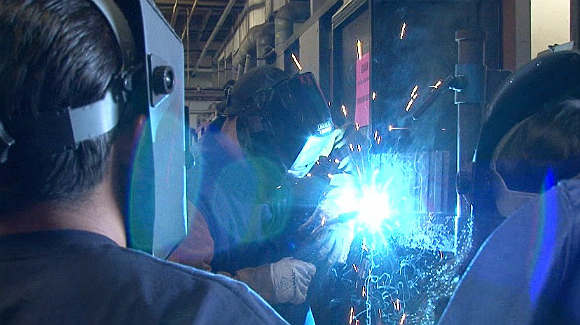
Welding demonstration for high school students at Cerritos College. (Photo Credit: John Guenther)
For those Californians worried about the hollowing out of the middle-class here, it’s important to note community college leaders see a proposed career technical education (CTE) funding bump as a $60-million step in the right direction.
In a win for the Summit’s workforce efforts, that money was set aside by Gov. Jerry Brown in his May revised budget as a one-time investment in college-level CTE, initially $50 million, and this week it’ll either be in the budget or out of the budget when the Legislature gets done with it.
“For too long, funding for our higher cost programs took a back seat to the other missions of the community colleges despite our more immediate and direct connection to the economy,” said Jeff A. Cummings, Executive Dean, Academic Affairs Dean, and Career and Technical Education Accreditation Liaison Officer at the College of the Redwoods. “Our ultimate goal is ensuring appropriate funding for all facets of the community colleges, which includes recognition of the particularized expenses for CTE. CCCAOE views the proposed funding as a catalyst to long-term stability for CTE programs in the community colleges.”
And the timing is right. Despite their importance to the workforce of California’s economy as a way to fill good-paying, in-demand jobs, CTE funding has declined and enrollment across all systems dropped by 100,000 in the 2012-2013 school year, according to California Department of Education.
The Governor’s proposed budget not only sets aside the millions this year specifically for career tech, it also acknowledges the higher costs associated with these programs—and proposes a new “shared investment” funding model along the lines the Summit has recommended.
That acknowledgement is significant, given that in several other states, CTE retains a higher stature and those types of programs in California currently are funded with the same per-seat formula as other, less-expensive programs, according to a report comparing 20 states’ vocational programs.
The budget also acknowledges the vital role these programs play in regional economies, pointing out that CTE programs should be used to “build upon existing regional capacity to better meet regional labor market demands.” And that’s what many college leaders have been already working on when trying to train workers to fill high-skill jobs that are available in their regions now and the future.
“The funding San Jose-Evergreen Community College District would receive, perhaps as much as $700,000, the allow us to expand career and technical education programs that are already providing our students with the specific, targeted skills and training Silicon Valley employers are looking for,” said San Jose Evergreen Community College District Chancellor Rita Cepeda. “In many cases, those companies are spending millions of dollars to recruit and relocate qualified candidates because they cannot satisfy their demand within our local workforce, and that must change.”
The Summit’s Workforce Action Team has made reversing a decade-long slide in state support for career technical education in community colleges a top priority this year—citing studies that show the median wages for graduates from these programs ($66,600) are nearly double those of other graduates ($38,500).
Because of their regional focus, community colleges are in a good position to tackle workforce issues and engage with companies nearby. San Jose-Evergreen Community College District has worked for some time to integrate vocational programs into their curriculum to satisfy the need for those technical workers in their region, says Cepeda.
But schools will also be looking toward more long-term funding beyond this one-time boost to keep up with the demand for trained and certified employees and to boost enrollment.
“There is reason for Californians to be concerned about the track record of one-time vs. long-term and stable funding for critical educational needs like career and technical education as it makes it difficult for many of our state’s community colleges to make effective adaptations to their curriculum and program offerings based upon one-time funding decisions,” said Cepeda.
The details of how that spending will be distributed and spent has to be worked out, but it’s a good place to start.
“If it remains one-time, we view it as an excellent starting point from which to begin discussions with the Administration and Legislature next year to establish long term sustainable funding for CTE,” said Cummings.

